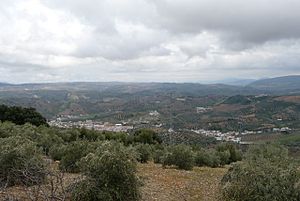Battle of Lauro facts for kids
Quick facts for kids Battle of Lauro |
|||||||
|---|---|---|---|---|---|---|---|
| Part of Caesar's Civil War | |||||||
 The battle probably took place in the mountainous hinterland of Hispania Ulterior. Pictured is the area around Algámitas, not far from Lora de Estepa. |
|||||||
|
|||||||
| Belligerents | |||||||
| Caesarians | Pompeians | ||||||
| Commanders and leaders | |||||||
| Lucius Caesennius Lento | Gnaeus Pompeius the Younger † | ||||||
| Units involved | |||||||
| Unknown | Survivors of Munda, including many Lusitanians | ||||||
| Strength | |||||||
| Many infantry and cavalry | Much fewer than the Caesarians | ||||||
| Casualties and losses | |||||||
| Unknown | Heavy | ||||||
The Battle of Lauro was a major fight in 45 BC during the Roman Civil War. It was the final battle for Gnaeus Pompeius the Younger. He was the son of Pompey the Great, a famous Roman general. This battle was against the armies loyal to Julius Caesar.
After a big defeat at the Battle of Munda, young Pompey tried to get away from Hispania Ulterior (modern-day Spain) by boat. But he was forced to land. Caesar's soldiers, led by Lucius Caesennius Lento, chased him. Pompey and his men were trapped on a wooded hill near a town called Lauro. Most of them, including Pompey the Younger, were killed there.
Contents
Why the Battle Happened
Pompey's Escape After Munda
After the Battle of Munda, Gnaeus Pompeius was badly hurt. He went to a town called Carteia. But even there, people were fighting amongst themselves. Some supported Pompey, and others supported Caesar.
The people who supported Caesar started a revolt in Carteia. Pompey was wounded again during this uprising. Things quickly turned bad for Pompey's side. So, they decided to get on their twenty remaining ships and sail away.
The Chase by Sea
A Roman naval commander named Gaius Didius was at Gades (a city nearby). He heard that Pompey's ships had escaped. Didius quickly set off to chase them.
Pompey's men had left Carteia in a hurry. They didn't bring enough drinking water. After four days of sailing, they had to land their ships. This allowed Didius to catch up with them. Caesar's forces attacked Pompey's fleet while it was anchored. They captured some ships and burned the rest. This trapped Pompey and his followers in southern Spain.
The Battle of Lauro
Flight and Discovery
After losing their ships, Pompey's men tried to escape by land. Caesar's soldiers kept chasing them and attacking them along the way. During this escape, Pompey the Younger was wounded again. This time, he was hurt in his shoulder and left leg. His men had to carry him on a stretcher.
The Pompeians eventually found safety on a wooded hill near the town of Lauro. This hill was easy to defend. However, a local person discovered them. This person told Caesar's soldiers where Pompey was hiding. As a result, Pompey and his men were surrounded.
The Siege and Breakout
Caesar's soldiers, led by Lucius Caesennius Lento, began to attack Pompey's position. But the natural defenses of the hill helped Pompey's men. They were able to fight off many attacks. Since they couldn't break through, Lento's forces decided to surround the hill. They planned to wait and starve out the Pompeians.
Pompey's defenders realized they couldn't stay there forever. They decided to try and break through the siege. When they started their escape attempt, very heavy and fierce fighting began. Many of the escaping Pompeians were killed.
Pompey's Final Moments
Some Pompeians, especially many Lusitanians (people from ancient Portugal), managed to get away. But Gnaeus Pompeius himself could not escape. His wounds made it impossible for him to walk. The rough land also meant he couldn't be carried by horse or stretcher quickly. He was left behind with some of his followers.
With many Pompeians gone or dead, Caesar's soldiers launched another attack. They quickly took over the remaining Pompeian position. Gnaeus Pompeius tried to hide in a cave. But some captured Pompeians told Caesar's men where he was. Despite his wounds, Pompey fought until he died.
What Happened Next
Displaying Pompey's Head
After the battle, Pompey the Younger's head was cut off. It was taken to Hispalis (a city in Spain). There, it was shown to the local people. This was a common practice in ancient times to show a victory.
Lusitanian Revenge
Meanwhile, the Lusitanians who had escaped the battle gathered many of their tribe members. They attacked the forces of Gaius Didius. Didius had set up a camp near the coast. The Lusitanians set fire to his ships that were on land. This made Didius leave his camp to fight.
When Didius and his men came out, the Lusitanians ambushed them. They killed Didius and many of his soldiers. The remaining Caesarian soldiers fled to their ships and escaped by sea.
Caesar's Return to Rome
After the Battle of Munda and Gnaeus Pompeius's death, Julius Caesar thought his enemies in Spain were completely defeated. He left only a few soldiers there to finish off any remaining resistance. Then, he returned to Rome.
However, Pompey's younger brother, Sextus Pompey, managed to escape Caesar's soldiers. He successfully rebuilt the Pompeian armies. By the time Caesar was killed in 44 BC, Sextus Pompey had taken back most of southern Spain for his family's cause.
See also
 In Spanish: Batalla de Lauro para niños
In Spanish: Batalla de Lauro para niños

